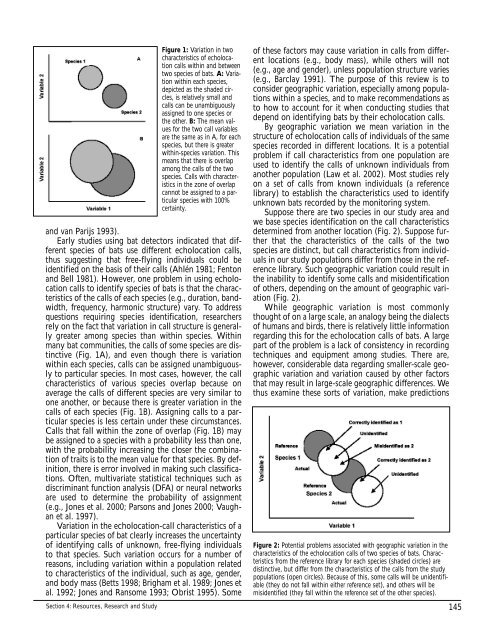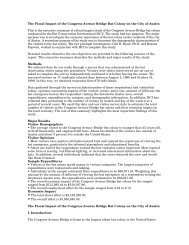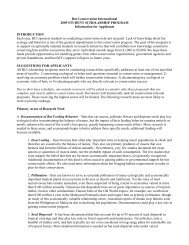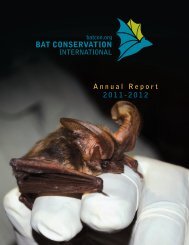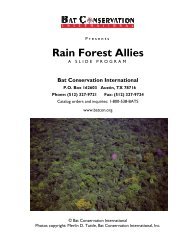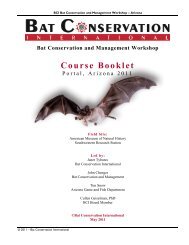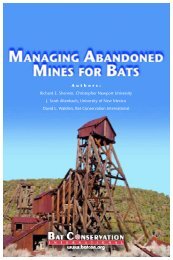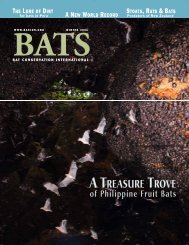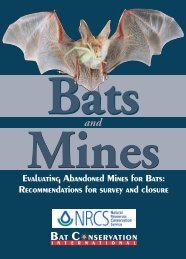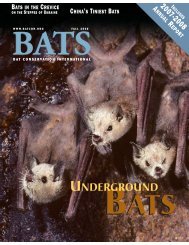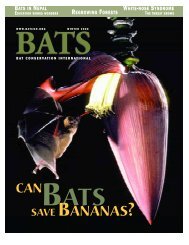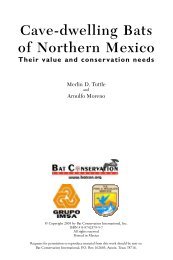Bat Echolocation Researc h - Bat Conservation International
Bat Echolocation Researc h - Bat Conservation International
Bat Echolocation Researc h - Bat Conservation International
You also want an ePaper? Increase the reach of your titles
YUMPU automatically turns print PDFs into web optimized ePapers that Google loves.
and van Parijs 1993).<br />
Early studies using bat detectors indicated that different<br />
species of bats use different echolocation calls,<br />
thus suggesting that free-flying individuals could be<br />
identified on the basis of their calls (Ahlén 1981; Fenton<br />
and Bell 1981). However, one problem in using echolocation<br />
calls to identify species of bats is that the characteristics<br />
of the calls of each species (e.g., duration, bandwidth,<br />
frequency, harmonic structure) vary. To address<br />
questions requiring species identification, researchers<br />
rely on the fact that variation in call structure is generally<br />
greater among species than within species. Within<br />
many bat communities, the calls of some species are distinctive<br />
(Fig. 1A), and even though there is variation<br />
within each species, calls can be assigned unambiguously<br />
to particular species. In most cases, however, the call<br />
characteristics of various species overlap because on<br />
average the calls of different species are very similar to<br />
one another, or because there is greater variation in the<br />
calls of each species (Fig. 1B). Assigning calls to a particular<br />
species is less certain under these circumstances.<br />
Calls that fall within the zone of overlap (Fig. 1B) may<br />
be assigned to a species with a probability less than one,<br />
with the probability increasing the closer the combination<br />
of traits is to the mean value for that species. By definition,<br />
there is error involved in making such classifications.<br />
Often, multivariate statistical techniques such as<br />
discriminant function analysis (DFA) or neural networks<br />
are used to determine the probability of assignment<br />
(e.g., Jones et al. 2000; Parsons and Jones 2000; Vaughan<br />
et al. 1997).<br />
Variation in the echolocation-call characteristics of a<br />
particular species of bat clearly increases the uncertainty<br />
of identifying calls of unknown, free-flying individuals<br />
to that species. Such variation occurs for a number of<br />
reasons, including variation within a population related<br />
to characteristics of the individual, such as age, gender,<br />
and body mass (Betts 1998; Brigham et al. 1989; Jones et<br />
al. 1992; Jones and Ransome 1993; Obrist 1995). Some<br />
Section 4: Resources, <strong>Researc</strong>h and Study<br />
Figure 1: Variation in two<br />
characteristics of echolocation<br />
calls within and between<br />
two species of bats. A: Variation<br />
within each species,<br />
depicted as the shaded circles,<br />
is relatively small and<br />
calls can be unambiguously<br />
assigned to one species or<br />
the other. B: The mean values<br />
for the two call variables<br />
are the same as in A, for each<br />
species, but there is greater<br />
within-species variation. This<br />
means that there is overlap<br />
among the calls of the two<br />
species. Calls with characteristics<br />
in the zone of overlap<br />
cannot be assigned to a particular<br />
species with 100%<br />
certainty.<br />
of these factors may cause variation in calls from different<br />
locations (e.g., body mass), while others will not<br />
(e.g., age and gender), unless population structure varies<br />
(e.g., Barclay 1991). The purpose of this review is to<br />
consider geographic variation, especially among populations<br />
within a species, and to make recommendations as<br />
to how to account for it when conducting studies that<br />
depend on identifying bats by their echolocation calls.<br />
By geographic variation we mean variation in the<br />
structure of echolocation calls of individuals of the same<br />
species recorded in different locations. It is a potential<br />
problem if call characteristics from one population are<br />
used to identify the calls of unknown individuals from<br />
another population (Law et al. 2002). Most studies rely<br />
on a set of calls from known individuals (a reference<br />
library) to establish the characteristics used to identify<br />
unknown bats recorded by the monitoring system.<br />
Suppose there are two species in our study area and<br />
we base species identification on the call characteristics<br />
determined from another location (Fig. 2). Suppose further<br />
that the characteristics of the calls of the two<br />
species are distinct, but call characteristics from individuals<br />
in our study populations differ from those in the reference<br />
library. Such geographic variation could result in<br />
the inability to identify some calls and misidentification<br />
of others, depending on the amount of geographic variation<br />
(Fig. 2).<br />
While geographic variation is most commonly<br />
thought of on a large scale, an analogy being the dialects<br />
of humans and birds, there is relatively little information<br />
regarding this for the echolocation calls of bats. A large<br />
part of the problem is a lack of consistency in recording<br />
techniques and equipment among studies. There are,<br />
however, considerable data regarding smaller-scale geographic<br />
variation and variation caused by other factors<br />
that may result in large-scale geographic differences. We<br />
thus examine these sorts of variation, make predictions<br />
Figure 2: Potential problems associated with geographic variation in the<br />
characteristics of the echolocation calls of two species of bats. Characteristics<br />
from the reference library for each species (shaded circles) are<br />
distinctive, but differ from the characteristics of the calls from the study<br />
populations (open circles). Because of this, some calls will be unidentifiable<br />
(they do not fall within either reference set), and others will be<br />
misidentified (they fall within the reference set of the other species).<br />
145


